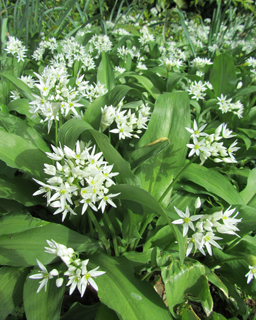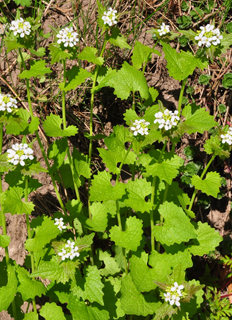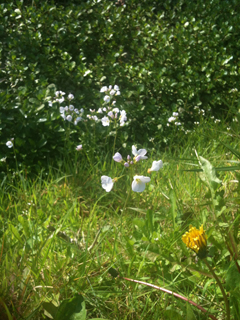 So, as promised, here’s a bit on wild garlic. Actually, let me start again, every time I think of any Allium, which is anything in the onion and garlic family, I get butterflies of excitement in my stomach! It’s a little mad but I love the fact that all of them have fantastic flavour and their own unique characteristics. Three cornered leek has a tasty spring onion like flavour and the flowers are out now, making a great addition to practically anything savoury as a garnish.
So, as promised, here’s a bit on wild garlic. Actually, let me start again, every time I think of any Allium, which is anything in the onion and garlic family, I get butterflies of excitement in my stomach! It’s a little mad but I love the fact that all of them have fantastic flavour and their own unique characteristics. Three cornered leek has a tasty spring onion like flavour and the flowers are out now, making a great addition to practically anything savoury as a garnish.
Crow garlic is so overlooked, both in name and trying to find it but it is delicious and garlicky in the form of chives. Wild leek is a beautiful slender winter treat to come across on chilly coastal walks. Rosy garlic is the elegant pink princess of late spring and early summer… but best of all is ramsons, aka wild garlic. Delicate broad leaves poke their heads up through the soil in late winter from rugby ball shaped bulbs in dappled hedgerows or grassy edges.
 As they grow taller and taller, they produce a stem with an explosion of white star flowers, turning into fiery green capers before ending in bullet like seeds. Every part of ramsons can be eaten. The leaves can be shredded and added to dishes instead of garlic, they can be wrapped around brie, breaded and deep fried, made into ramson garlic bread, finely chopped and added to salsas or dips, made into ramson pesto with toasted pine nuts or flaked almonds or if you run out of ideas, blitz them with olive oil and pour the whole lot into ice cube trays for later use.
As they grow taller and taller, they produce a stem with an explosion of white star flowers, turning into fiery green capers before ending in bullet like seeds. Every part of ramsons can be eaten. The leaves can be shredded and added to dishes instead of garlic, they can be wrapped around brie, breaded and deep fried, made into ramson garlic bread, finely chopped and added to salsas or dips, made into ramson pesto with toasted pine nuts or flaked almonds or if you run out of ideas, blitz them with olive oil and pour the whole lot into ice cube trays for later use.
The unripe seeds, before they ripen to form the seeds, are excellent for pickling and make fantastic garlic capers for salad dressings or to pair with strong cheeses served on crackers. I can’t get enough of them at the moment – I’ve been adding ramsons to curries, cheese on toast, savoury muffins, rice salads… I only wish their season was longer!!
So that’s the majority of Alliums, let’s move on to Brassicas. Brassicas are plants in the mustard family and this generally is any plant that contains sulphur compounds and has 4 petals in a cross shape (old family name was Cruciferae referring to the cross-like shape of the petals) . Anything that has a mustard or cabbage-like smell to it is a Brassica. There are some real gems coming up at this time of the year, including garlic mustard, lady’s smock and black mustard.
 Garlic mustard is the perfect cross-over between an Allium and a Brassica. A delicious tender leaf with acid-green new growth, it works well in salads and also as a green sauce or remoulade for lamb chops. Lady’s smock is a delicate pink flowering Brassica which looks like hairy bittercress on steroids. You often find this growing in damp grass such as meadows or by streams and the pink flowers give them away (I expect you’ve probably walked passed them many times, not noticing them when they are in leaf). The taste is like a sweet, hot cress which makes an excellent addition to sandwiches, salads and as a dip.
Garlic mustard is the perfect cross-over between an Allium and a Brassica. A delicious tender leaf with acid-green new growth, it works well in salads and also as a green sauce or remoulade for lamb chops. Lady’s smock is a delicate pink flowering Brassica which looks like hairy bittercress on steroids. You often find this growing in damp grass such as meadows or by streams and the pink flowers give them away (I expect you’ve probably walked passed them many times, not noticing them when they are in leaf). The taste is like a sweet, hot cress which makes an excellent addition to sandwiches, salads and as a dip.
Lastly, black mustard is an absolute must to try. You often find this growing by the coast and on disturbed soil. The leaves are rough and it produces yellow flowers in the summer. The taste is fantastic – have a nibble on the leaves and wait for the slow release of heat, like wasabi. When you think you can’t take the heat any more, the heat subdues and sweetens. Try making sushi and add it as a garnish with pickled ginger or if you aren’t keen on the heat, steam it like a vegetable as it loses the heat and when it is tender serve it with a little melted butter as a side dish.
 Generally most spring bulbs are to be avoided, such as bluebells and Narcissus, but tulip petals can be eaten and the flower and stem can be stuffed and steamed until cooked. The bulbs have been cooked and eaten but they sound more like a famine food. Camassias on the other hand have tasty bulbs when roasted and they look like little round shallots. Their gorgeous blue flowers look fantastic as a garnish or added to a salad.
Generally most spring bulbs are to be avoided, such as bluebells and Narcissus, but tulip petals can be eaten and the flower and stem can be stuffed and steamed until cooked. The bulbs have been cooked and eaten but they sound more like a famine food. Camassias on the other hand have tasty bulbs when roasted and they look like little round shallots. Their gorgeous blue flowers look fantastic as a garnish or added to a salad.
One last thing which I must mention for its unusual delicious flavour is magnolia. If you haven’t tried magnolia petals, stop reading this, get outside and go and hunt down your nearest magnolia tree. There are many different types and each with varying colours and flavours, but the overlying taste is a combination of ginger and chicory. One of the best ones I have tried is Magnolia loebneri ‘Leonard Messel’ with stunning shell pink flowers and a fantastic ginger flavour. Try them fresh, as an edible canape dish, steeped in vinegar, made into a syrup or even dried and ground to produce a spice for making biscuits.
100g butter
15 large ramson leaves
Sea salt
Black pepper
1 French baguette
Preheat the oven to 200 degrees C. Wash the ramson leaves, shake off any excess water and finely slice. Put them in a bowl with the butter and seasoning and mash together with a fork or a wooden spoon until combined. Take the baguette and make slices only ¾ of the way through and at an angle, about an inch apart all the way along. Spread the butter mix in between the slices and if there is any left over, spread some over the top of the baguette. Wrap in foil, pop it in the oven for about 10 minutes, open up the foil and cook for a further 5 minutes. Enjoy! Simple but delicious. If you want to try other alternatives, why not add a couple of tablespoons of wild thyme or finely chopped rosemary?

